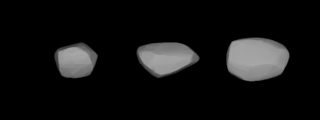Related Research Articles

157 Dejanira is a main belt asteroid that was discovered by Alphonse Borrelly on 1 December 1875, and named after the warlike princess Deianira in Greek mythology. The Dejanira family of asteroids is named after it.

254 Augusta is a main-belt asteroid, discovered on 31 March 1886 by astronomer Johann Palisa at Vienna Observatory, Austria. The stony S-type asteroid measures about 12 kilometers in diameter. It is the first-numbered member of the Augusta family, after which the small Asteroid family and subgroup of the main-belt has been named. Augusta was named after the German–Austrian writer Auguste von Littrow (1819–1890), widow of astronomer Carl Ludwig von Littrow, who was a former director of the Vienna Observatory.

261 Prymno is a somewhat large Main belt asteroid. It is classified as a B-type asteroid and probably has a primitive composition not unlike common C-type carbonaceous asteroids.

340 Eduarda is a main belt asteroid that was discovered by German astronomer Max Wolf on 25 September 1892 in Heidelberg. It was named after German banker and amateur astronomer Heinrich Eduard von Lade.
500 Selinur is a minor planet, specifically an asteroid orbiting in the asteroid belt. Like 501 Urhixidur and 502 Sigune, it is named after a character in Friedrich Theodor Vischer's then-bestseller satirical novel Auch Einer.

572 Rebekka is a minor planet orbiting the Sun, which was discovered on September 19, 1905, by a German astronomer Paul Götz in Heidelberg. It was named after a young lady from Heidelberg, and may have been inspired by the asteroid's provisional designation 1905 RB.
586 Thekla is a minor planet orbiting the Sun. It was named after Saint Thecla of the first century. The name may have been inspired by the asteroid's provisional designation 1906 TC.

605 Juvisia is a minor planet, specifically an asteroid orbiting in the asteroid belt that was discovered 27 August 1906 in Heidelberg by German astronomer Max Wolf. It was named after the commune Juvisy-sur-Orge, France, where French astronomer Camille Flammarion had his observatory.
633 Zelima is a minor planet orbiting the Sun in the asteroid belt with a magnitude of 10.7. The name may have been inspired by the asteroid's provisional designation 1907 ZM.
696 Leonora is a Meliboean asteroid orbiting the Sun in the asteroid belt. It was discovered 10 January 1910 by American astronomer Joel Hastings Metcalf, at Taunton, Massachusetts. It was named by Arthur Snow of the United States Naval Observatory, who computed the orbit for the planet, after his wife, Mary Leonora Snow.
768 Struveana is a minor planet orbiting the Sun. The asteroid was named jointly in honor of Baltic German astronomers Friedrich Georg Wilhelm von Struve, Otto Wilhelm von Struve and Karl Hermann Struve.
947 Monterosa is a minor planet orbiting the Sun.
985 Rosina, provisional designation 1922 MO, is a stony asteroid and sizable Mars-crosser on an eccentric orbit from the inner regions of the asteroid belt, approximately 8 kilometers in diameter. It was discovered on 14 October 1922, by astronomer Karl Reinmuth at the Heidelberg-Königstuhl State Observatory in Germany. The asteroid's name is a common German female name, unrelated to the discoverer's contemporaries.
990 Yerkes is a main belt asteroid discovered by Belgian-American astronomer George Van Biesbroeck in 1922, and named after the Yerkes Observatory.
991 McDonalda is a Themistian asteroid. It was discovered by Otto Struve in 1922 at the Yerkes Observatory in Williams Bay, Wisconsin, United States. It is named after the McDonald Observatory, which Struve helped found in 1939.
999 Zachia is a main-belt asteroid that was discovered by German astronomer Karl W. Reinmuth in 1923 and named after Hungarian astronomer Franz Xaver von Zach.
2227 Otto Struve, provisional designation 1955 RX, is an asteroid from the inner regions of the asteroid belt, approximately 4.7 kilometers in diameter. The asteroid was discovered on 13 September 1955, by the Indiana Asteroid Program at Goethe Link Observatory near Brooklyn, Indiana, United States. It was named after Russian astronomer Otto Struve.
78431 Kemble (provisional designation 2002 QJ50) is a background asteroid from the inner regions of the asteroid belt, approximately 1.4 kilometers (0.9 miles) in diameter. It was named after Father Lucian Kemble. The asteroid was discovered on 16 August 2002, by astronomer Andrew Lowe on images taken at the Palomar Observatory, California, United States.
6144 Kondojiro (1994 EQ3) is an asteroid discovered on 14 March 1994 by Kin Endate and Kazuro Watanabe at the Kitami Observatory in eastern Hokkaidō, Japan. It is named after Jiro Kondo, a Japanese Egyptologist and professor of archaeology at Waseda University.
7449 Döllen, provisional designation 1949 QL, is a stony Florian asteroid from the inner regions of the asteroid belt, approximately 3.5 kilometers in diameter. It was discovered on 21 August 1949, by German astronomer Karl Reinmuth at the Heidelberg Observatory in southwest Germany. The likely S-type asteroid has a rotation period of 10 hours. It was named after German astronomer Wilhelm Döllen.
References
- ↑ "992 Swasey (1922 ND)". JPL Small-Body Database . NASA/Jet Propulsion Laboratory . Retrieved 2 May 2016.
- ↑ Lutz D. Schmadel (2011). Dictionary of Minor Planet Names. Addendum to Fifth Edition: 2006–2008. Springer. ISBN 978-3-642-01966-1.